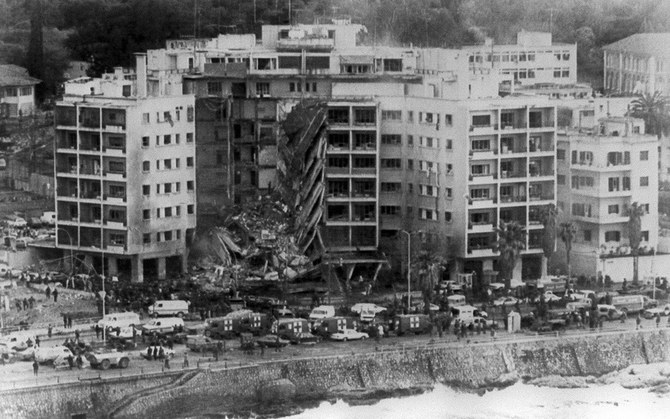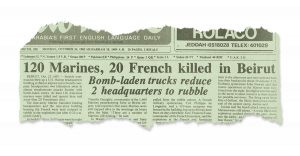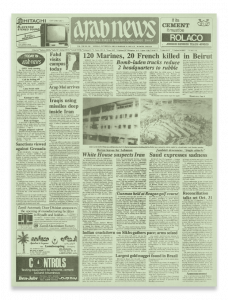- ARAB NEWS
- 09 Jul 2025

Najia Houssari
The suicide attack on barracks in the capitol signalled the emergence of an Iranian role in the Lebanese conflict
Summary
On Oct. 23, 1983, 241 American soldiers were killed and dozens wounded as a result of the suicide bombing that targeted the Marines in Beirut, in what was described as the largest non-nuclear explosion since World War II.
This suicide bombing was the second of its kind witnessed by the Lebanese capital after the first suicide bombing in April that year that targeted the American embassy and killed 63 people, including 17 Americans at the embassy and its surroundings.
The bombers were associated with Iran and a movement that called itself the Islamic Amal Movement. Its Lebanese leader, Hussein Al-Moussawi, affirmed his association with the Iranian revolution and that the ties of the movement with the Iranian revolution were like the ties of “a nation with its leader.”
The two explosions came at a time when Lebanon was witnessing a civil war in light of an Israeli occupation that reached Beirut and the entry of multinational forces into Lebanon to protect its capital. The withdrawal of the American and then the French forces after the two attacks left Beirut open to the chaos that brought with it more killing and destruction.
BEIRUT: It was about 6:25 on the morning of Oct. 23, 1983 when Beirut and its suburbs were shaken, all the way to the mountainous regions, due to an almost muffled explosion.
People thought that it was an earthquake, but seven minutes later the city and its surroundings were again shaken by a second massive explosion.
A multinational US, French and Italian peacekeeping force is sent to Beirut to oversee withdrawal of Palestine Liberation Organization fighters.

US Marines withdraw.
Lebanese President Bachir Gemayel is assassinated.

Christian militia, assisted by Israeli troops, massacre hundreds of Muslims in Sabra and Shatila refugee camps.

US Marines return to Beirut.
Seventeen Americans are among 63 killed in a bombing of the US embassy in Beirut.

Truck bomb kill 241 US personnel and wounds 128 more at Marines’ compound in Beirut. Second truck bomb kills 58 French paratroopers stationed a few kilometers away.

A US court rules that the truck bombing was ordered by Iran and carried out by Hezbollah.
At the time, I was working for the Lebanese newspaper As-Safir as a war correspondent. Beirut was besieged by clashes erupting on the axes of its southern suburb, the mountain and the Kharoub region, between the Progressive Socialist Party and its allies on the one hand, and the Lebanese forces on the other, or what was known as the Mountain War.
The south was witnessing armed resistance against the Israeli occupation by Lebanese fighters who were involved in leftist parties and previously in Palestinian factions. The multinational forces, including the Americans, French and Italians, were still stationed in Beirut in the wake of the withdrawal of fighters and the leadership of the Palestine Liberation Organization as a result of the Israeli aggression on Lebanon and Israel’s occupation of Beirut in 1982.
After a few minutes, it became clear that the Marines’ headquarters on the Beirut Airport Road and the headquarters of the French paratroopers in the Jinnah area had been hit by two explosions caused by two unknown suicide bombers. They had stormed the two fortified headquarters with two trucks loaded with tons of explosives.
It was Lebanon’s second unprecedented suicide bombing, after the first that targeted the American embassy in the Ain Al-Mraiseh area in Beirut six months earlier, on April 18, 1983.
The damage was enormous at the headquarters of the Marines. Four layers of cement had collapsed and been turned into a pile of rubble, flames were still burning, and there were a lot of screaming, blood, body parts and confusion. This is what has stuck in my memory, and what we journalists could see amid the chaos.
The Marines were partying the night before, Saturday, with the Megaband music group that had come from the US to entertain them. The explosion occurred while they were sleeping.
No party claimed responsibility for the bombings that day, but the As-Safir newspaper published a statement it received a few days later, in which the “Islamic Revolution Movement” claimed responsibility.
About 48 hours after the bombing, the US accused the Amal Movement and its splinter, the Islamic Amal Movement, led by Hussein Al-Moussawi, of being responsible for the bombing. According to information published by local newspapers at the time, “The bombing arrangement took place in Baalbek, and the truck used for the explosion was seen parked in front of an Amal Movement center.”
The American vice president, George H.W. Bush, visited Lebanon the day after the attack and said: “We will not allow terrorism to dictate or change our foreign policy.”

“Acts of violence in Lebanon, not matter how sanguinary and heartsickening, have become almost routine for that country.”
From an Arab News editorial, Oct. 24, 1983
Syria, Iran and the Amal Movement then denied involvement in the two attacks.
France responded to the attack on its forces by sending eight military jets to bomb the Sheikh Abdullah barracks in Baalbek, where “Iranian elements are stationed.” It declared at the time that “the raids killed 200 people.”
An Islamic Amal official denied in a statement that “Iran had a compound in the Baalbek region,” but stressed that his group’s association with “the Islamic revolution in Iran is the association of a nation with its leader and we are defending ourselves.”
On Nov. 23, the Lebanese cabinet decided to cut off its relationship with Iran and Libya. The Lebanese Foreign Minister at the time, Eli Salem, said that the decision “was taken after Iran and Libya admitted that they have forces in the Bekaa.”

As-Safir newspaper quoted a diplomatic source as saying that “relations with Iran have worsened due to the illegal interventions, practices and activities it carried out on the Lebanese scene, despite the many warnings.”
The October bombings were the strongest indication of the reversal of the balance of regional and international power in Lebanon and the emergence of a growing Iranian role in the conflict on Lebanese soil.
“Before 1982, Beirut embraced all kinds of opposition, the educated elite, that is, the velvet opposition, and the armed opposition whose members were being trained in Palestinian camps or training camps in the Bekaa and the south,” strategic researcher Walid Noueihed told Arab News.
“The Iranian opposition to the Shah was one of these. Beirut was an oasis for the opposition with regional and international consensus until 1982, when Israel invaded Lebanon and besieged Beirut and pushed toward the exit of the Palestine Liberation Organization, according to an international agreement that required Israel not to enter Beirut in exchange for the Palestinians leaving Lebanon.”
Noueihed explained that while the Palestinian factions left Lebanon, the Lebanese fighters who were part of the PLO in Lebanon did not. Most of them were Shiites who formed the reservoir of Lebanese leftist parties.
He said that “the bombings of the Marines’ headquarters and the French paratroopers led to the withdrawal of the multinational forces from Lebanon, and Beirut became, for the second time, without protection. New resistance operations increased according to ideologies unrelated to the left. The Islamic Amal Movement and its slogans to confront Israel came out into the open.”
In 1985, Hezbollah announced its birth, defining itself as “a jihadi organization leading a revolution for an Islamic republic.” This party received support from parties on the Lebanese and Palestinian left, especially after the collapse of the Soviet Union. “We began to witness the liquidation of national resistance symbols, and we thought that the intention was to exclude all forces from the resistance field and limit it to one party, that is, Hezbollah,” Noueihed said.
“Iranian influence crystallized with the violent fighting that took place between Hezbollah and Amal, which claimed dozens of casualties and ended with Hezbollah assuming control in light of the Syrian military presence in Lebanon,” Noueihed said. “Beirut turned into an arid city abandoned by hundreds of writers, intellectuals, researchers and media to Europe for fear of being liquidated.”